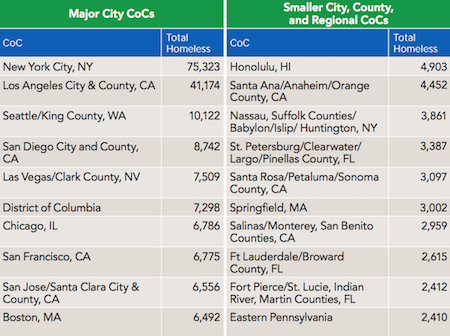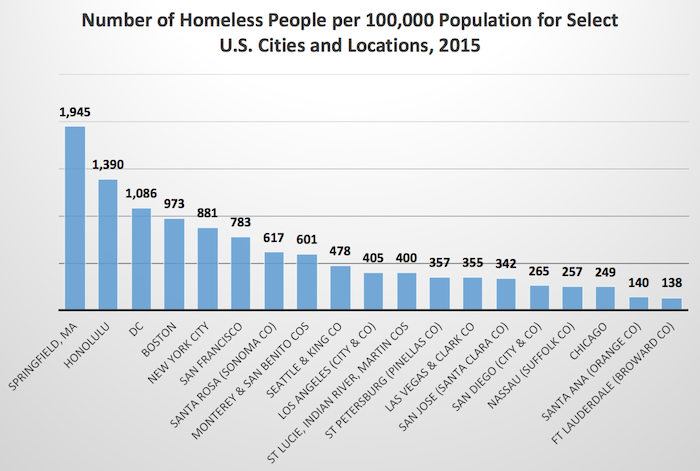Homelessness has surged in some U.S. cities. According to the Wall Street Journal, from 2010 to 2015, homelessness increased 42% in New York City and 12% in Seattle.
A November 2015 report (PDF) by the U.S. Department of Housing and Urban Development (HUD) ranked the top 10 large cities and top 10 small cities by their homeless populations. These counts were conducted on a single night in January.

As shown, the top three large cities (or geographic areas) with the biggest homelessness problem are NYC, Los Angeles, and Seattle, while the top three small locations are Honolulu, Orange County, and Suffolk County (on Long Island, NY).
While this is useful information, it does not put homelessness into its proper statistical context. NYC and Los Angeles are two of the largest cities in the world, so it's not a surprise that they have sizable homeless populations. On the other hand, Honolulu is not a particularly large city, yet it has nearly 5,000 homeless.
It would be far better to re-analyze this data as the number of homeless people per 100,000 population, the same way that epidemiologists and demographers measure phenomena such as mortality and homicide*. I have performed that analysis below:

Now, the data shows something radically different. Considering the large city and small city data as a single set, the cities struggling with the biggest homelessness problem are Springfield (MA), Honolulu, Boston, NYC, and San Francisco. NYC falls from #1 to #5, Los Angeles from #2 to #10, and Seattle from #3 to #9. Sonoma County (ranked #7), which was considered a "small city" by HUD, actually has a big city homelessness problem.
There may be some issues with the data. For instance, it seems odd that a town the size of Springfield, MA (a population of only 154,341) would have 3,000 homeless. Perhaps HUD meant the entire metropolitan statistical area, which has a population of 631,982. If that's the case, then it has 475 homeless per 100,000, which means the magnitude of its homelessness problem is similar to that of Seattle. Likewise, Honolulu's homeless population seems rather high. If HUD was referring to Honolulu County (population: 998,714), the prevalence drops to 491 per 100,000.
The bottom line is that, just like crime data, homelessness data must be analyzed within the context of overall population size.
Source: U.S. Department of Housing and Urban Development. "The 2015 Annual Homeless Assessment Report (AHAR) to Congress. PART 1: Point-in-Time Estimates of Homelessness." November 2015. (PDF)
*Population estimates were obtained from American FactFinder, a website operated by the U.S. Census Bureau. Eastern Pennsylvania was omitted from the analysis because the geographic region was not clearly defined.




